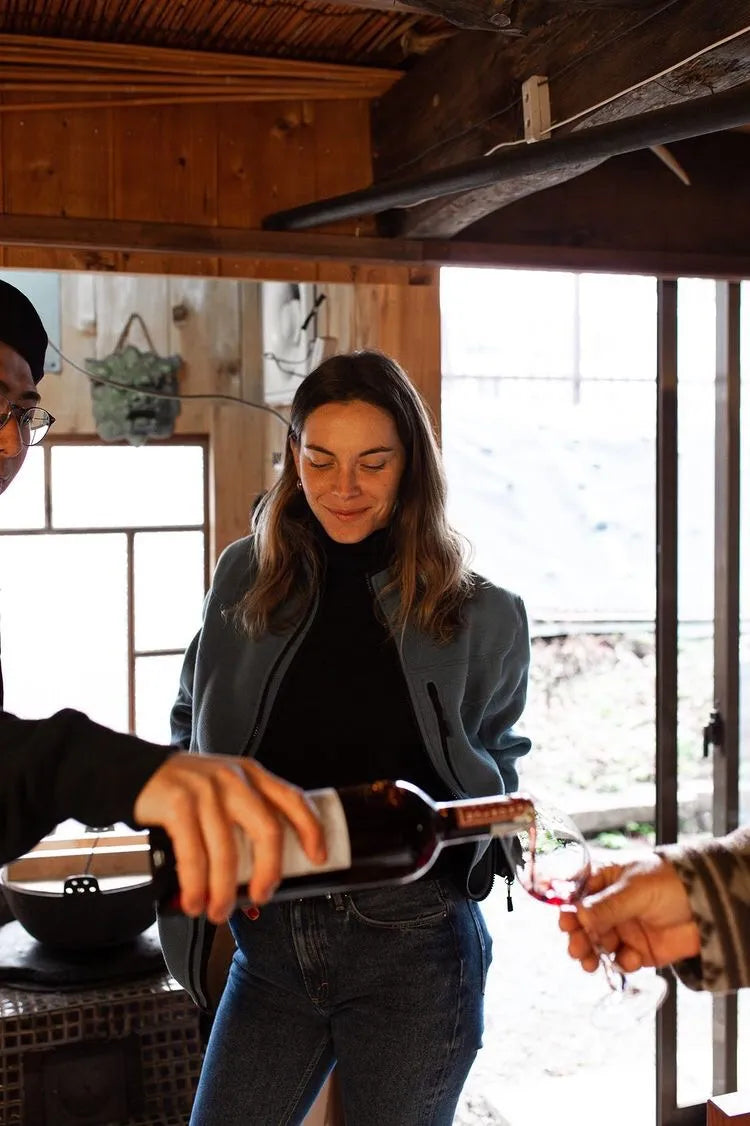Karla Sutra is recognized for her subtle aphrodisiac tiles, hiding her lovemaking figures in intricate choreographies. She considers her erotic azulejos as a sensual manifesto, convinced that our societies desperately need sensuality. Starting out as a street artist, making optical illusions on paper, she aims to spread the message to as many people as possible, now applying her craft to tiles, tableware and the many opportunities that come her way. We met up with the multimedia artist in Paris to discuss her work ‘Sauteries Illusionnistes’ and the links between the erotic, sensuality, food and fire.

Jonathan Soriano: Tell us about Karla Sutra?
Karla Sutra: I am Karla Sutra. It is my nickname from starting out in street art. I started out by making optic illusions of tiles. I am also doing tiles now, but at that time it was optic illusions on paper. When you first look at them, they look like regular tiles, but when you get closer, you can see a drawing of erotic figures. I was integrating it in the architecture of different cities. I did a lot in Paris, because I am based here of course, but also in New York, Berlin, anywhere I was traveling. Naturally, I turned to ceramics, to do real tiles, and to work with architecture in a different way, especially in restaurants, which is part of my network, and something I am interested in. I learned ceramics in a small studio, the old-fashioned way.
To me there’s a deep link between ceramics and the erotic. When you touch the clay, it is sensual, and you use fire to heat it to these really high temperatures. I found some logic in that. And because of my link to restaurants, it made sense to create a tableware line. I make ‘surprise plates’, where the drawing is in the middle, so when you eat, it appears, and it surprises you. The relation between food, eating, it is all very sensual.
J: Where do you make your tiles and tableware?
K: I try to find traditional artisans and being respectful of their craft. I found craftsmen where I grew up La Bisbal in Catalunya. Now they do the tiles and tableware for me. I am still doing special projects by hand in my studio. Karla Sutra has become a vessel of possibilities and people come to me with ideas of what they can do with my work.
Caroline Berner Kühl: Can you say a few words about your studio?
K: I work in a big studio in Montrouge, that I share with street artists, because I like to stay in different worlds. I still take inspiration from street art, because when you are on the street, it is always very political.

C: And as you said, you come from a background in street art?
K: I was looking for something to express myself in the street. I was inspired by other street art and was drawn to it.
J: What was it about it?
K: I was just naturally looking at it all the time. And I liked the idea of saying something to people in the streets. It is democratic in a way.
J: When did you come to Paris?
K: I was 19
J: You’ve been traveling from here? It sounds like the traveling helped you evolve as an artist?
K: Travel is the main point. And when I lived in New York for a few months, I realized that I needed to emerge myself fully in my art. The city is so creative, and it feels like there are so many different temporalities. From Basquiat to hip hop to street art today. I came back to Paris, quit my job working in fashion, and supported my street art by working in restaurants.
J: Sounds like hip hop gave you the courage?
K: You could say.
C: And how about the erotic?
K: I was always inspired by the erotic. To me there’s a sensuality in almost everything. Your relationship with the sun, with nature, there’s a link with chefs, with food, with produce. If you think about chemistry, it is found in wine and in food, but also in lovemaking.
J: It is an interesting interpretation. Everyone has different views on these things.
C: I like that idea of nature. Because often when we think erotic, we totally miss the sensual part. It is obvious in your work how it tells us that the erotic can be sensual and vice versa. Whereas often we separate it and focus solely on the sexual part of the erotic. Even though that is part of it too, it is just so much more. Unfolding it, exploring it in this way, it feels like a new way to express ourselves.

K: Exactly. Even when I started out making street art, the erotic was not part of it, but now it’s much more common. And I am glad it’s like that. What I wanted to say to people in the street, my message was that the erotic is part of life. It can be beautiful. For me, the portrayal of erotic stuff at the time, it was too dark and too much. It lacked intimacy. I wanted it to be more subtle, have a double-vision: as you get closer, you discover more and more.
C: Sounds like it’s the same as with the food? You discover it when you eat?
J: Looking at your work, it is not in your face, you don’t immediately think erotic. I could even look at it with my children. Introducing it to children like this, it takes out the taboo. It is like poetry.
C: I think that is exactly what we forgot about with the erotic, the poetic dimension of it. What I first thought about when I looked at your art is that it is such a normal part of life, the erotic is part of everyone’s life.
K: It is truly what I want to say.
J: And it’s important that it becomes less taboo, because it’s so often used to control people.
C: And it’s important that we continue to liberate. Because male and female sexuality is so often perceived in different ways. At least that’s my experience that we are still supposed to suppress female sexuality.
K: There’s definitely a political element in it. And as I see more of the world, I become more engaged in politics. We need to focus on sensuality. For me that is the only way.
J: And speaking on behalf of men now, there’s a lot of men who are just down with the sensual. But the problem is that it is not manly enough. Male sexuality has become a symbol too.
C: It is also not about men and women as such, it is about a patriarchal society that sets the standards. It becomes a question of not the individual, but about a system. And everyone replicates patriarchy because that’s what we grew up with. It takes real effort to step outside of that.
K: Which is why it is so important for me to continue to show.



